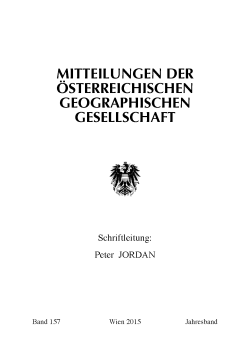 |
 |
Österreichische Geographische Gesellschaft
Mitteilungen der Österreichischen Geographischen Gesellschaft
157. Jg. (Jahresband), Wien 2015
Ioana Scridon,
Oana-Ramona Ilovan
S. 151 - 168 doi: 10.1553/moegg157s151
Abstract:
In this paper, we report on the Zipsers’ community in Vişeu de Sus/Oberwischau, Romania. This ethnic group is one of the most relevant examples out of the German-speaking ethnic groups in Eastern and Southeastern Europe that living together and sharing space with other ethnic groups lead to characteristic adaptations and influence the appearance of another ethnic substratum visible through its own culture (language, tradition, religion, etc.). Our aim was to show that multiculturalism may in some cases, such as the Zipsers’ in Vişeu de Sus/Oberwischau, support identity and traditional culture preservation. The material of our research rested on respondents’ autobiographies and on ethnographic inquiry as resulted from interviews, questionnaires and observation, on statistical data from censuses, on information from earlier studies and on our theoretical reflection. Results showed that the specificity of this ethnic group and especially of its perpetuation was exactly the multicultural substratum that enabled respecting the Other, communication and help-based ethnic relationships, that is “living together”. We concluded that the Zipsers’ construction of ethnic identity was done depending on the Other, as a result of social transformation and of fragmenting triggered by political events.
Zipsers, identity, interethnic relationships, qualitative research methods, ‘the Other’, multiculturalism Published Online:
2016/02/16 12:11:44 Object Identifier:
0xc1aa5576 0x0032bbbb
Rights:All rights reserved.For questions regarding copyright and copies please contact us by email.
Themenschwerpunkt
„Zehn Jahre EU-Osterweiterung – geographische Bilanz eines mutigen Schrittes“
Die Fachzeitschrift "Mitteilungen der Österreichischen Geographischen Gesellschaft" (früher "Mitteilungen der k.k. Geographischen Gesellschaft in Wien")
• ist das wichtigste regelmäßig erscheinende Organ der "Österreichischen Geographischen Gesellschaft",
erscheint seit 1857 und ist die älteste noch existierende Fachzeitschrift geographischen Inhaltes im deutschen Sprachraum,
• vermittelt neue Erkenntnisse aus allen Bereichen der Geographie, Kartographie und verwandter Raumwissenschaften,
• informiert über Fachfragen in Forschung und Lehre, nationale und internationale geographische Aktivitäten, sowie Personalia,
• veröffentlicht die Österreich-Bibliographie und Rezensionen der neuesten Literatur,
publiziert Gesellschaftsnachrichten,
• erscheint im Umfang von mindestens 400 Druckseiten (mit Kartenbeilagen) im Jahr
|


 Home
Home Print
Print
 References
References
 Share
Share

